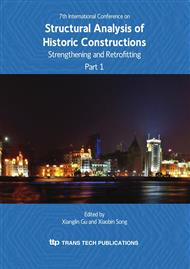p.1219
p.1225
p.1233
p.1241
p.1247
p.1253
p.1259
p.1265
p.1271
Remediation of Historic Buildings and Patrimony by Bacterially Induced Mineralization
Abstract:
Laboratory experiments were conducted to protect and consolidate historic architectural heritages by bacterially induced carbonate mineralization on the surface of samples of marble and concrete. Some properties of samples and mineral, such as the composition and growth of the mineral deposited on samples, porosity or pore size distribution of samples, the efficiency of protection, the bond behavior between the deposited mineral and substratum, were analyzed by X-ray diffraction, scanning electron microscopy, mercury intrusion porosimetry and ultrasonic test. The results show that the phases of mineral crystal are calcite and vaterite, and the calcium source has an effect on the phase of calcium carbonate mineralization and precipitation. Bacteria act as nucleation sites in the course of precipitation of the mineral crystallization, and the crystal is deposited uniformly on the surface and subsurface of the matrix. The precipitation has no significant effect on the pore size distribution of the matrix, but results in a decrease of porosity, and mineral crystals are strongly attached to the substratum. Bacterial mineralization for remediation of historic buildings can be an ecological and novel alternative to traditional techniques.
Info:
Periodical:
Pages:
1253-1258
Citation:
Online since:
October 2010
Authors:
Price:
Сopyright:
© 2010 Trans Tech Publications Ltd. All Rights Reserved
Share:
Citation:



